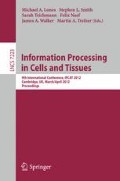Abstract
Artificial Signalling Networks (ASNs) are computational models inspired by cellular signalling processes that interpret environmental information. This paper introduces an ASN-based approach to controlling chaotic dynamics in discrete dynamical systems, which are representative of complex behaviours which occur in the real world. Considering the main biological interpretations of signalling pathways, two ASN models are developed. They highlight how pathways’ complex behavioural dynamics can be captured and represented within evolutionary algorithms. In addition, the regulatory capacity of the major regulatory functions within living organisms is also explored. The results highlight the importance of the representation to model signalling pathway behaviours and reveal that the inclusion of crosstalk positively affects the performance of the model.
Access this chapter
Tax calculation will be finalised at checkout
Purchases are for personal use only
Preview
Unable to display preview. Download preview PDF.
References
Alon, U.: An introduction to systems biology: design principles of biological circuits. Chapman & Hall/CRC Mathematical and Computing Biology Series (2007)
Arias, M.A., Hayward, P.: Filtering transcriptional noise during development: concept and mechanisms. Nature Reviews Genetics 7(1), 34–44 (2006)
Bray, D., Lay, S.: Computer simulated evolution of a network of cell signalling molecules. Biophysical Journal 66, 972–977 (1994)
Chirikov, B.V.: Research concerning the theory of nonlinear resonance and stochasticity. Tech. rep., Institute of Nuclear Physics, Novosibirsk (1962)
Deckard, A., Sauro, M.H.: Preliminary studies on the in silico evolution of biochemical networks. Chembiochem. 5(10), 1423–1431 (2004)
Decraene, J., Mitchell, G.G., McMullin, B.: Evolving artificial cell signalling networks: Perspectives and Methods. SCI, vol. 6, pp. 167–186 (2009)
Huang, Z., Hahm, J.: Fuzzy modeling of signal transduction networks. In: Proc. 17th World Control, The International Federation of Automatic Control, pp. 15867–15872 (2008)
Klamt, S., Saez-Rodriguez, J., Lindquist, J.A., Simeoni, L., Giles, D.E.: A methodology for the structural and functional analysis of signalling and regulatory networks. BMC Bioinformatics 7(56), 1–26 (2006)
Lones, M.A., Tyrrell, A.M., Stepney, S., Caves, L.S.: Controlling Complex Dynamics with Artificial Biochemical Networks. In: Esparcia-Alcázar, A.I., Ekárt, A., Silva, S., Dignum, S., Uyar, A.Ş. (eds.) EuroGP 2010. LNCS, vol. 6021, pp. 159–170. Springer, Heidelberg (2010)
Morris, K.M., Saez-Rodriguez, J., Sorger, K.P., Lauffenburger, A.D.: Logic-based models for analysis of cell signalling networks. Biochemistry 4(49), 3216–3224 (2010)
Sachs, K., Gifford, D., Jaakkola, T., Sorger, P., Lauffenburger, D.A.: Bayesian networks approach to the cell signalling pathway modeling. Science’s STKE 148, 38–42 (2002)
Stepney, S.: Nonclassical computation: a dynamical systems perspective. In: Rozenberg, G., Bäck, T., Kok, N.J. (eds.) Handbook of Natural Computing, vol. 2, ch. 52. Springer, Heidelberg (2011)
Said, M.R., Oppenheim, A.V., Lauffenburger, D.A.: Modelling cellular signal processing using interacting Markov chains. In: Proc. International Conference on Acoustic, Speech, Signal Processing (ICASSP 2003), Hong Kong, pp. 41–44 (2003)
Schroer, C.G., Ott, E.: Targeting in Hamiltonian systems that have mixed regular/chaotic phase spaces. Chaos 7, 512–519 (1997)
Tulupyev, A., Nikolenko, S.: Directed Cycles in Bayesian Belief Networks: Probabilistic Semantics and Consistency Checking Complexity. In: Gelbukh, A., de Albornoz, Á., Terashima-Marín, H. (eds.) MICAI 2005. LNCS (LNAI), vol. 3789, pp. 214–223. Springer, Heidelberg (2005)
Ziegler, J., Banzhaf, W.: Evolving control metabolisms for a robot. Artificial Life 7, 171–190 (2001)
Author information
Authors and Affiliations
Editor information
Editors and Affiliations
Rights and permissions
Copyright information
© 2012 Springer-Verlag Berlin Heidelberg
About this paper
Cite this paper
Fuente, L.A., Lones, M.A., Turner, A.P., Stepney, S., Caves, L.S., Tyrrell, A.M. (2012). Evolved Artificial Signalling Networks for the Control of a Conservative Complex Dynamical System. In: Lones, M.A., Smith, S.L., Teichmann, S., Naef, F., Walker, J.A., Trefzer, M.A. (eds) Information Processign in Cells and Tissues. IPCAT 2012. Lecture Notes in Computer Science, vol 7223. Springer, Berlin, Heidelberg. https://doi.org/10.1007/978-3-642-28792-3_7
Download citation
DOI: https://doi.org/10.1007/978-3-642-28792-3_7
Publisher Name: Springer, Berlin, Heidelberg
Print ISBN: 978-3-642-28791-6
Online ISBN: 978-3-642-28792-3
eBook Packages: Computer ScienceComputer Science (R0)

